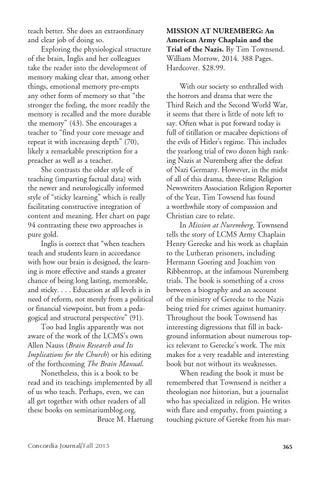teach better. She does an extraordinary and clear job of doing so. Exploring the physiological structure of the brain, Inglis and her colleagues take the reader into the development of memory making clear that, among other things, emotional memory pre-empts any other form of memory so that “the stronger the feeling, the more readily the memory is recalled and the more durable the memory” (43). She encourages a teacher to “find your core message and repeat it with increasing depth” (70), likely a remarkable prescription for a preacher as well as a teacher. She contrasts the older style of teaching (imparting factual data) with the newer and neurologically informed style of “sticky learning” which is really facilitating constructive integration of content and meaning. Her chart on page 94 contrasting these two approaches is pure gold. Inglis is correct that “when teachers teach and students learn in accordance with how our brain is designed, the learning is more effective and stands a greater chance of being long lasting, memorable, and sticky. . . . Education at all levels is in need of reform, not merely from a political or financial viewpoint, but from a pedagogical and structural perspective” (91). Too bad Inglis apparently was not aware of the work of the LCMS’s own Allen Nauss (Brain Research and Its Implications for the Church) or his editing of the forthcoming The Brain Manual. Nonetheless, this is a book to be read and its teachings implemented by all of us who teach. Perhaps, even, we can all get together with other readers of all these books on seminariumblog.org. Bruce M. Hartung Concordia Journal/Fall 2015
MISSION AT NUREMBERG: An American Army Chaplain and the Trial of the Nazis. By Tim Townsend. William Morrow, 2014. 388 Pages. Hardcover. $28.99. With our society so enthralled with the horrors and drama that were the Third Reich and the Second World War, it seems that there is little of note left to say. Often what is put forward today is full of titillation or macabre depictions of the evils of Hitler’s regime. This includes the yearlong trial of two dozen high ranking Nazis at Nuremberg after the defeat of Nazi Germany. However, in the midst of all of this drama, three-time Religion Newswriters Association Religion Reporter of the Year, Tim Towsend has found a worthwhile story of compassion and Christian care to relate. In Mission at Nuremberg, Townsend tells the story of LCMS Army Chaplain Henry Gerecke and his work as chaplain to the Lutheran prisoners, including Hermann Goering and Joachim von Ribbentrop, at the infamous Nuremberg trials. The book is something of a cross between a biography and an account of the ministry of Gerecke to the Nazis being tried for crimes against humanity. Throughout the book Townsend has interesting digressions that fill in background information about numerous topics relevant to Gerecke’s work. The mix makes for a very readable and interesting book but not without its weaknesses. When reading the book it must be remembered that Townsend is neither a theologian nor historian, but a journalist who has specialized in religion. He writes with flare and empathy, from painting a touching picture of Gereke from his mar365
